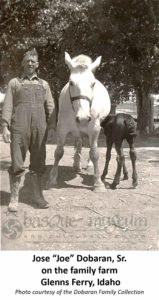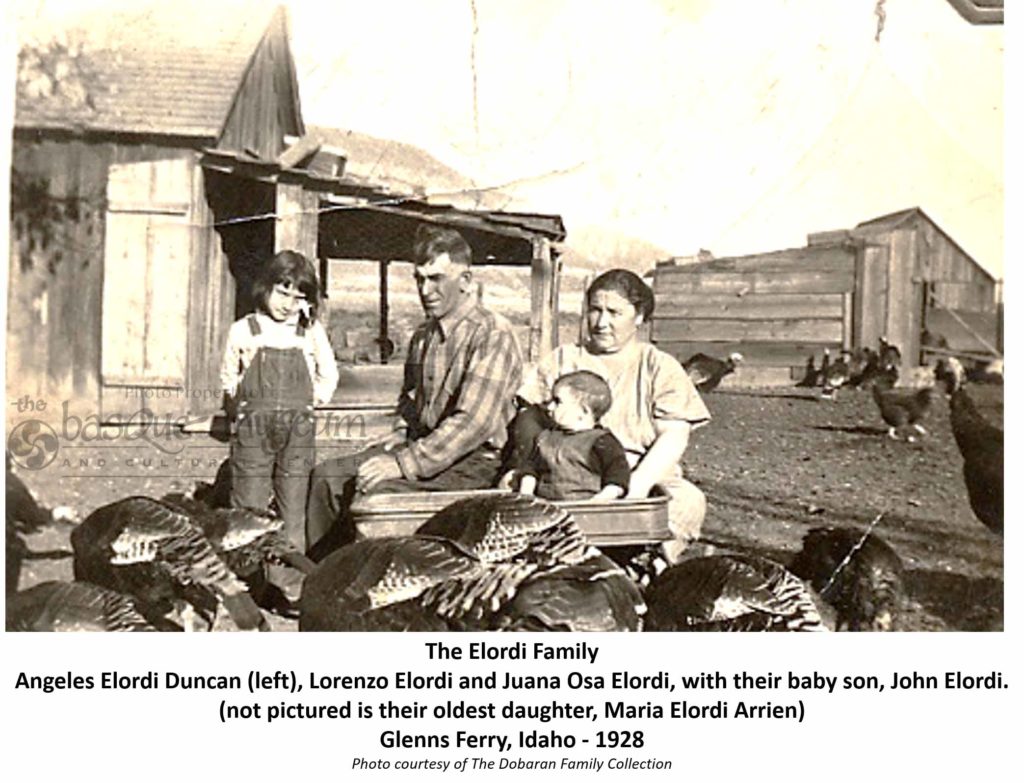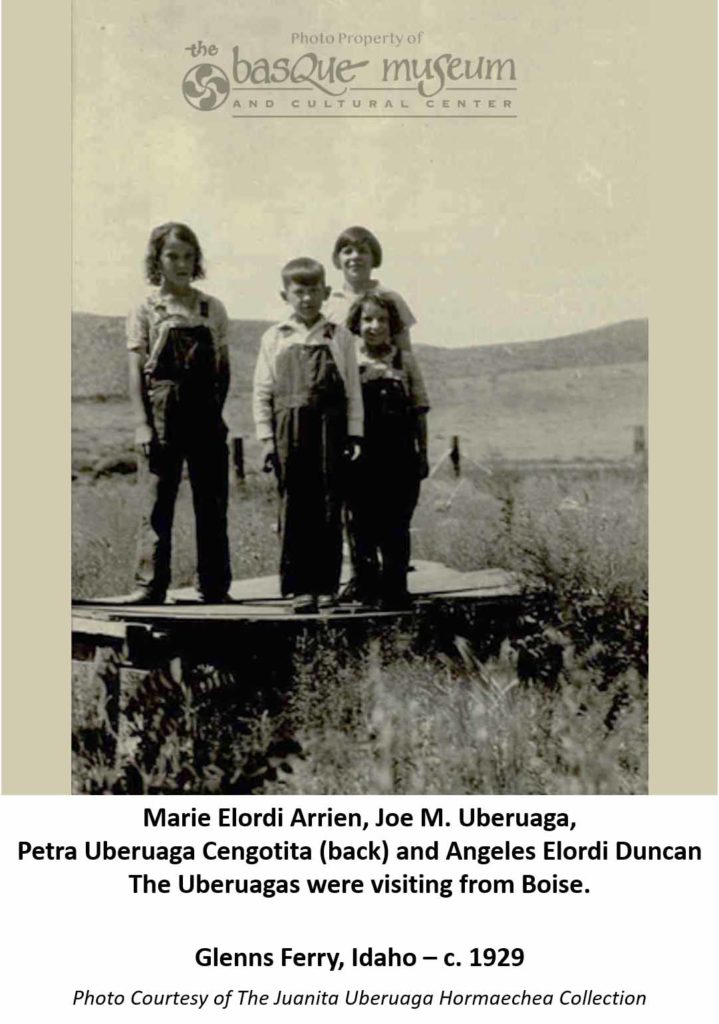Immigration to the western gold fields was over the Old Oregon Trail in 1842. The best possible place to cross the Snake River for many miles was at the Three Island Ford, and it was a much-used crossing. Gustavus F. Glenn, owner of an 8 x 8 outfit (freight wagon) met the need for the safe crossing for freighters moving much needed supplies to the gold fields by building a ferry boat to cross the Snake River in 1863. Glenn’s Ferry was located about a mile down river from the present site of the town.
William and Mary Stockton gave the railroad a strip of their preempted land and located Glenns Ferry at its present site just north and west of the original settlement in 1883. The Stockton’s farmhouse remains on the corner of Commercial and Garfield Streets.
In 1884 the Oregon Shortline Railroad was completed to Huntington, Oregon, bisecting the present townsite. 1886 was the building of the roundhouse, shops were moved in from Idaho Falls, and a depot, coal platform, ice house, pump house, store and office building were built, making Glenns Ferry an important division point for the railroad by 1887.
The school district was organized in 1884, consisting of Glenns Ferry, King Hill, and Cold Springs.
The 1900’s saw the beginning of many businesses including a butcher shop, druggist, and lumber supplier. In 1904 the King Hill Tract was opened by the Carey Act, and work was begun on the irrigation system, bringing more prosperity to the town. A water system and electric plant was built in 1905 and a steamboat named “Helen” plied the waters of the Snake River. The first newspaper was published in 1908 and helped announce the opening of the King Hill Irrigation system on July 12, 1911 by stating, “FOR ONE DAY ONLY. ALL GLENNS FERRY LOTS $50….A FREE WATER RIGHT FOR GENERAL IRRIGATION PURPOSES FURNISHED WITH EACH LOT.” A Contract with the Federal Government to finish the irrigation system was made in 1918.
Glenns Ferry was incorporated as a village in 1910, complete with its own bank, which was founded in 1904, and “electrick lites” in May 13, 1911 which were put in by the Shoshone Lite and Power Company. The Glenns Ferry Improvement Club was formed in 1914; one of their projects being the village cemetery, named by Mrs. Sim Collins “Glenn Rest” in 1917. By 1927 the village had a bandstand moved to Hull Memorial park from downtown, and a library which was located in the village office.
Glenns Ferry continued to prosper with the Union Pacific Railroad, and the farming brought by the King Hill Irrigation Project, for many years. The “village” has seen the waxing and waning of prosperity, businesses, homes and industry, and continues to thrive. In fact, these old-timers would be amazed if they knew that Glenns Ferry was no longer a railroad terminal, and that immense tracts of land were under cultivation, one farm alone bigger than all of the King Hill Irrigation Tract.
Source: Crossroads – The History of the Elmore County Area by Sandra Ransel and Charles Durand. Published by the Elmore County Historical Research Team, Mtn. Home, Idaho. 1985. Pgs. 70-71
(Click on images to enlarge)
Glenns Ferry had continued to grow and expand for about three decades before the arrival of the first known Basque families to the area.
Jeannie (Aldape) Eiguren, a granddaughter of Jose Ramon Dobaran and Francisca (Larrondo) Dobaran, recounted the story that her grandparents came to the U.S. in 1915. Hilario Larrondo had come to United States previously, arriving on October 18, 1909 via Le Havre, France and had worked as a laborer building Arrowrock Dam and had also worked in construction in Wyoming before returning to his hometown of Loiu, Bizkaia (Lujua, Vizcaya). He and his sister had a double wedding with Hilario Larrondo marrying Maria Gastanaga and Francisca Larrondo marrying Jose Ramon Dobaran on April 28, 1915.  They left the Basque Country shortly thereafter from the port in Bordeaux, France, arriving in the United States on May 12, 1915. The passenger manifest states that they are traveling to Boise City to stay with “a friend, Mateo Arregui, on Idaho Street.” The two couples then traveled to Boise, Idaho. Family lore says they stayed with Maria Epelde, who may have been working at or managing the Capitol Rooming House, on Idaho Street before purchasing the property with Crusa Arostegui from Jose Arregui in March of 1916. From there the two couples received word that the Slick Ranch was in need of employees in Glenns Ferry, Idaho. Both couples were offered positions which they took and began establishing themselves in that community.
They left the Basque Country shortly thereafter from the port in Bordeaux, France, arriving in the United States on May 12, 1915. The passenger manifest states that they are traveling to Boise City to stay with “a friend, Mateo Arregui, on Idaho Street.” The two couples then traveled to Boise, Idaho. Family lore says they stayed with Maria Epelde, who may have been working at or managing the Capitol Rooming House, on Idaho Street before purchasing the property with Crusa Arostegui from Jose Arregui in March of 1916. From there the two couples received word that the Slick Ranch was in need of employees in Glenns Ferry, Idaho. Both couples were offered positions which they took and began establishing themselves in that community.
By the late 1940s, the Larrondo, Dobaran, Gamboa and Elordi families had all left the Glenns Ferry area and the Basque presence there was not as significant as it was a decade earlier.
Hilario Larrondo and Maria Gastanaga Larrondo initially found work on the Slick Ranch in Glenns Ferry, Idaho soon after arriving in 1915. They lived on at least 2 different farms in the Glenns Ferry area – in the southern part of Glenns Ferry on the Davis Ranch and in about 1926 they moved to the McGinnis Ranch which was located some 5 to 10 miles north of town. About a year later as their daughter Isabel was preparing to start school, the family decided to move into town. In 1928 the family moved to an area north of the highway and lived there for eight years. They grew hay, had a large garden and raised and sold turkeys and turkey eggs. In 1937, after farming in Glenns Ferry for over 20 years, the Larrondo family led a four day caravan of multiple wagons westward to the Treasure Valley. The Larrondo’s established a farm on west Franklin Road in Meridian, Idaho which they, and then their son, Joe, owned and managed. Hilario and Maria Gastanaga Larrondo had seven children. Fernando “Fergie” (1915), Jose “Joe” (1917), Eloy (1918-1922), Anna (1920), Isabel (1921), Mary (1923) and John (1927).
Their granddaughter, Marie Jausoro Day, recalls a story that when her mother, Isabel Larrondo Jausoro (born in 1921), was just an infant, the wagon in which she and her mother, Maria Gastanaga Larrondo, were riding in was stopped in Glenns Ferry near the train tracks. The train was also stopped there. When the steam engine blew its whistle, the horses spooked and bolted, throwing Maria out of the wagon, still holding her infant child in her arms. She landed horribly and broke her leg, spending months in the hospital recovering. The children were sent to various homes to be cared for. Their aunt, Francisca Larrondo Dobaran, took in at least two of the children, with Anna Larrondo moving permanently to stay and be raised by the Stein Family of Glenns Ferry.
Jose and Francisca Dobaran, along with Hilario and Maria Gastanaga Larrondo, found work at the Slick Ranch in 1915 shortly after they immigrated to the United States. They were later able to purchase their own property where they established a dairy business in Glenns Ferry, Idaho.  They lived there from 1915 to 1944. Besides milk, they also sold eggs and maintained a small herd of sheep and other farm animals. The Dobaran’s had nine children. [Maria “Marie” (1916), Angela “Angie” (1917), Flora (1919), Pilar “Pete” (1920), Lydia (1923), Louis “Lou” (1924), Jose, Jr. “Joe” (1926), Frances “Francie” (1929) and John (1930)].
They lived there from 1915 to 1944. Besides milk, they also sold eggs and maintained a small herd of sheep and other farm animals. The Dobaran’s had nine children. [Maria “Marie” (1916), Angela “Angie” (1917), Flora (1919), Pilar “Pete” (1920), Lydia (1923), Louis “Lou” (1924), Jose, Jr. “Joe” (1926), Frances “Francie” (1929) and John (1930)].  Almost all of the children were involved in school activities. The oldest, Marie, couldn’t speak English and had hearing loss in one ear, so she was held back in school and was then sent, along with her sister, Angela “Angie”, so she would have someone she could speak Basque with and the two of them helped each other. It is interesting to note that four of the five Dobaran sisters played in organized sports, especially excelling in basketball, in high school. This participation may have contributed to them becoming very confident, competitive, and independent women.
Almost all of the children were involved in school activities. The oldest, Marie, couldn’t speak English and had hearing loss in one ear, so she was held back in school and was then sent, along with her sister, Angela “Angie”, so she would have someone she could speak Basque with and the two of them helped each other. It is interesting to note that four of the five Dobaran sisters played in organized sports, especially excelling in basketball, in high school. This participation may have contributed to them becoming very confident, competitive, and independent women. Based on information from Glenns Ferry High School records, the Dobaran boys were also involved in sports and activities. Granddaughter, Tina Dobaran Shaw recalls that Jose “Joe” Dobaran, Sr. would take hot pepper sandwiches on homemade bread to the school for his children to eat for lunch.
Based on information from Glenns Ferry High School records, the Dobaran boys were also involved in sports and activities. Granddaughter, Tina Dobaran Shaw recalls that Jose “Joe” Dobaran, Sr. would take hot pepper sandwiches on homemade bread to the school for his children to eat for lunch.
 Tina also shared that her grandfather told his oldest child, Marie Dobaran, that he would fund her additional studies and training at the business school in Boise, Idaho if she would then help the next sibling with her education. Subsequent siblings did the same to help the next in line. The Dobaran’s moved to Boise to be closer to family as their older daughters had left Glenns Ferry to study and work in Boise.
Tina also shared that her grandfather told his oldest child, Marie Dobaran, that he would fund her additional studies and training at the business school in Boise, Idaho if she would then help the next sibling with her education. Subsequent siblings did the same to help the next in line. The Dobaran’s moved to Boise to be closer to family as their older daughters had left Glenns Ferry to study and work in Boise.
Jose and Francisca established the Cloverdale Dairy Farm in Boise, Idaho at the corner of Cloverdale and Franklin roads. This property was adjacent to the Larrondo’s farm that was on the Boise/Meridian border. Jose Ramon and Francisca ran the dairy from 1944 until they retired in 1958. Their sons, Joe and John, continued to run the operation in Boise on the property, with Joe continuing on after John moved to another occupation. Pilar “Pete” Dobaran built a brick home on the Dobaran property and she lived there with her parents, her sister, Francie, widowed brother, Joe, and his daughter, Tina Dobaran. It was a gathering place for all of the Dobaran children and grandchildren.
Gregorio “George” Gamboa was originally from Arramayona, Alava. He had come to the United States in 1908. Rita Goicoechea had arrived in 1919 and she and George were married in Mountain Home, Idaho on April 9, 1921.  By 1922 they had established themselves as residents of Glenns Ferry. In the 1930 census, George Gamboa is identified as being a “firelighter” in the round house affiliated with the Union Pacific Railroad. The family later moved to Pocatello and their three sons, Frank, Joe, and Angelo, all served in the military during WWII.
By 1922 they had established themselves as residents of Glenns Ferry. In the 1930 census, George Gamboa is identified as being a “firelighter” in the round house affiliated with the Union Pacific Railroad. The family later moved to Pocatello and their three sons, Frank, Joe, and Angelo, all served in the military during WWII. 
 Lorenzo and Juana (Osa) Elordi, also immigrants from Bizkaia, although married in Boise, Idaho, settled with their family in Glenns Ferry. Photos from the late 1920s indicate that they may have raised turkeys for their livelihood. They had two daughters and a son, Maria Elordi Arrien, Angeles Elordi Duncan, and John Elordi.
Lorenzo and Juana (Osa) Elordi, also immigrants from Bizkaia, although married in Boise, Idaho, settled with their family in Glenns Ferry. Photos from the late 1920s indicate that they may have raised turkeys for their livelihood. They had two daughters and a son, Maria Elordi Arrien, Angeles Elordi Duncan, and John Elordi.
David and Marie (Bordalecu) Ayarra moved to a farm in retirement in nearby King Hill in 1972 and Marie attended Mass at Our Lady of the Limerick in Glenns Ferry for many years.
The Larrondos had seven children between 1915 and 1927 and the Dobaran’s had nine children between 1917-1930. Add the Gamboa children to the mix and the three families contributed a number of students to the Glenns Ferry school population. They were involved in basketball, football, and track as well as helping with work on their parents’ properties.